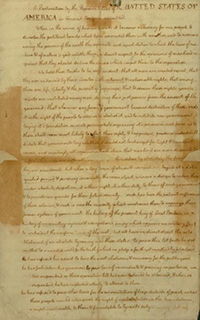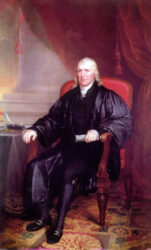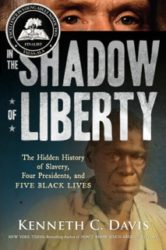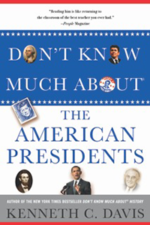(Post revised and updated 6-21-2023) Second in a series that begins here.
Now that Juneteenth has become a national holiday observed as the other “Independence Day,” it is time to look back on the first Independence Day –July 4th, 1776. As the nation is going through an examination of the central role slavery played in American History, it is important to recognize its place at Philadelphia. You cannot teach American History without acknowledging slavery as central to the foundation of the nation. And talking about the men who signed the Declaration is one way to do that.

Fair Copy of the Draft of the Declaration of Independence (Source New York Public Library)
…We mutually pledge to each other our Lives, our Fortunes , and our Sacred Honor.
Here are the next five Signers of the Declaration, continuing in alphabetical order. A “YES” denotes an enslaver or slave trader; “NO” means the person did not enslave people.

Samuel Chase by John Beale Bordley Collection of the Maryland State Archives Public Domain
–Samuel Chase (Maryland) A 35-year-old attorney, Chase is among those signers who did not vote on July 4; he signed the later printed version in August. Accused of wartime profiteering but never tried or convicted, he later went broke from business speculating and settled into law practice. President George Washington appointed him to the Supreme Court, and Chase became the first justice to be impeached –although he was acquitted in 1805 by the Senate in a trial presided over by Vice President Aaron Burr.
The failure of the Senate to convict allowed Chase to return to the Supreme Court and serve 6 more years as an associate justice. More importantly, the acquittal deterred the House of Representatives from using impeachment as a partisan political tool.
Read more about Chase’s impeachment and acquittal.
Chase returned to the Supreme Court and died of a heart attack in 1811 at age 70. YES
Learn more about Impeachment history in my Smithsonian article here.
-Abraham Clark (New Jersey) An attorney, 50 years old at the signing, Clark had two sons who were captured and imprisoned during the war; one on the notorious British prison ship Jersey and the other in a New York jail cell. Clark served in Congress on and off and opposed the Constitution’s ratification until the Bill of Rights was added. He died in 1794 at age 68. YES
–George Clymer (Pennsylvania) A 37-year-old merchant the time of the signing, Clymer was a well-heeled patriot leader who helped fund the American war effort. He was also elected to Congress after the July 2 independence vote, signing the Declaration on August 2. He belongs to an elite group who signed both the Declaration and the Constitution. (The others were Roger Sherman of Conn,; George Read of Del.; and Benjamin Franklin, Robert Morris and James Wilson, all of PA.) He continued to prosper after the war and died in 1813 at age 74. NO
-William Ellery (Rhode Island) A modestly successful merchant turned attorney, aged 48 at the signing, Ellery replaced an earlier Rhode Island delegate who died of smallpox in Philadelphia. (Smallpox killed more Americans than the war did during the Revolution.) A dedicated member of Congress during the war years, Ellery saw his home burned by the British although it is thought unlikely they knew it was the home of a Signer. An abolitionist, he was rewarded after the war by President Washington with the lucrative post of collector for the port of Newport which he held for three decades. He died in 1829, aged 92, second in longevity among signers after Carroll. NO
-William Floyd (New York) At the signing, a 41-year-old land speculator born on Long Island, New York, Floyd abstained from the July 2 independence vote with the rest of the New York delegation. But he is thought to be the first New Yorker to sign the Declaration on August 2. Reports that his home on Fire Island was destroyed by the British were exaggerated, although it was used as a stable and barracks by the occupying Redcoats. (It is now part of a Fire Island National Park.) Floyd served in the first Congress before moving to western New York where he owned massive land tracts and where he died at age 86 in 1821. YES
Read “The American Contradiction: Conceived in Liberty, Born in Shackles” Social Education, March/April 2020
In the Shadow of Liberty: The Hidden History of Slavery, Four Presidents, and Five Black Lives


Don’t Know Much About® History: Anniversary Edition


